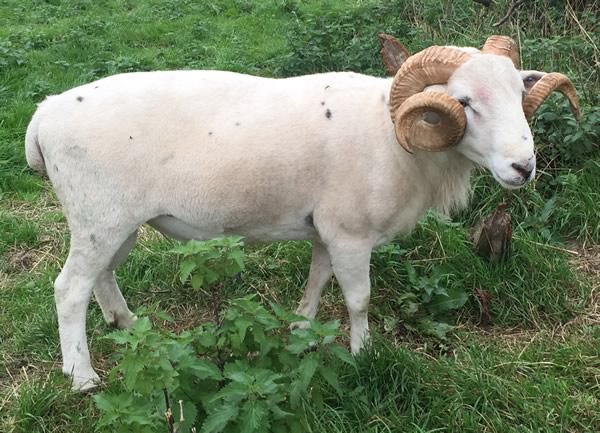
The Wiltshire Horn is a traditional native breed especially suited to the UK climate. They are hardy and prefer to be outside whatever the weather. At Witley Well, we run a pedigree flock comprising approximately 45 breeding ewes. We usually have 2 or 3 rams, so at the beginning of November we split the girls into breeding groups, introduce the boys and then the lambs are born from the beginning of April. We lamb outside, only bringing them in for 24-48 hours to make sure all is well. We normally get a good lambing percentage of 175%. The lambs aren't given any supplementary feed but are turned out onto our herb rich pastures where they grow well. They are weaned in August with the best being registered and sold as breeding stock or kept to supplement our own flock. The remainder go for meat at 7-8 months and we also keep a number back as store lambs producing fantastic hogget the following spring.
A Native Breed
The Wiltshire Horn Sheep is thought to have been introduced to Britain by the Romans. As the name suggests they were well suited to the chalky hills of Wiltshire with its rich valleys and poor hilltops. In the 18th Century it is estimated that they totalled about 700,000 in the downs and pastures of the county. After the revolution in the sheep industry started by Robert Bakewell (1725-95), other breeds were introduced and crossbreeds produced, which led to the decline of the Wiltshire Horn. In 1923 the Pedigree of Wiltshire Horn and the Breed Society was established.
Today the breed is in Category 6 of the Rare Breed Survival Trust Watch list but is seeing a steady growth in numbers as their natural ability to convert grass to meat without too much other input is being recognised once again.
No shearing
The Wiltshire Horn has a short fleece that naturally sheds in the spring leaving a short hair coat, as the picture shows. The fleece then starts to grow again in the autumn to provide protection for the winter months. This self shedding ability eliminates the time and cost involved in gathering sheep for shearing, dagging and dipping, and for the small flock keeper, the difficulty in finding shearers willing to shear small numbers of sheep. The short summer coat helps to cut down the incidents of fly strike.
Easy Lambing
The Wiltshire Horn ewes have large frames and are good, milky mothers which lamb easily. Lambs have remarkable vitality at birth and are born with a thick hair coat which protects against the elements. The breed is equally suited to indoor or outdoor lambing systems.
Ideal Crossing Breed
The Wiltshire Horn is an ideal crossing breed. Rams are used as superior terminal meat sires producing lambs which are lively at birth and finish quickly. The large framed Wiltshire Horn ewe accepts rams from all the widely used terminal breeds producing top quality prime lamb. Wiltshire Horn ewes are now being used in many commercial flocks where, with careful selective breeding, they are able to produce wool shedding replacements.
Flavoursome Meat
The Wiltshire Horn produces fabulously full flavoured meat as now demanded by an increasingly discerning public. Lambs have the ability to grow to heavy weights without putting on excess fat to meet modern grading requirements and are able to finish off grass. The exceptional quality of the meat is ideally suited to niche market outlets such as farmers markets and farm gate sales.
To find out more about this fantastic breed visit www.wiltshirehorn.org.uk


